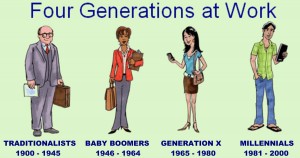Each of the four major generational groups in America – Traditionalists, Baby Boomers, Generation X and Millennials – have been forged by varied influences and have greatly different values and expectations.
 Traditionalists, those born from 1900 to 1945, were shaped by the Great Depression, two world wars and the dawn of the space age. They lived through or were shaped by parents who survived the Great Depression. The Traditionalists experienced hard times while growing, were followed by times of prosperity.
Traditionalists, those born from 1900 to 1945, were shaped by the Great Depression, two world wars and the dawn of the space age. They lived through or were shaped by parents who survived the Great Depression. The Traditionalists experienced hard times while growing, were followed by times of prosperity.
Baby Boomers, born 1946 to 1964, were shaped by the civil rights movement, the Vietnam War, the sexual revolution and the Cold War. They include the post-war babies who grew up to be the radicals of the 70s and yuppies of the 80s. As children they were promised “the American dream” and they pursue that promise. As a result they are seen as being greedy, materialistic and ambitious.
Generation X, born 1965 to 1980, were forged by Watergate, the energy crisis, dual income and single parent families. They are the first generation of latchkey kids and have been influenced by the end of the Cold War, working mothers and an increased divorce rate. They are considered to be the first generation that will not do as well financially as their parents did.
Millennials, born 1981 to 2000, grew up in an era of AIDS, 9/11, terrorist attacks and school shootings. They were more sheltered than previous generations as parents strived to protect them from the evils of the world. They came of age in a period of economic expansion and were the first generation of children with schedules.
While Traditionalists considered education a dream, Baby Boomers looked on it as a birthright, Generation X saw it as a way to get there and the Millennials think of it as an incredible expense.
Traditionalists focused on family and community, the Boomers zeroed in on success, Generation X worried about time and the Millennials seem to be all about individuality. Traditionalists dealt with money by paying cash and emphasizing saving, while Baby Boomers believed in buy now, pay later. Generation X returned to cautious spending and savings emphasis, while Millennials simply earn to spend.
Traditionalists believe in hard work, respect for authority and put seniority and company first. Baby Boomers are driven to be workaholics with long hours and a solid work ethic. Generation X believes in working smarter, not longer and are more self-reliant while Millennials are into multitasking and have an entrepreneurial bent.
Traditionalists think of Hoover Dam when considering technology. Baby Boomers think of the microwave, while Generation X thinks of what they can hold in their hand – a cell phone or PDA. Millennials consider technology to be more intangible and communicate via the internet, picture phones and e-mail.
Traditionalists are more likely to communicate one-on-one or by writing a memo. Boomers grew up with touch-tone phones and a call me anytime attitude, while Generation X has cell phones and a cal me only at work attitude.
Traditionalists are likely to be discrete, Boomers diplomatic, Generation X blunt, direct and immediate and Millennials are polite and rely on voice mail and e-mail as primary tools, though they will communicate in person for very important messages.
What motivates the generations? For Traditionalists it is respect and security. Baby Boomers want to be valued and needed and see money as the ultimate reward. Generation X wants freedom, no rules and time off. Millennials are motivated by time off and want to work with other bright people.
Family and work are compartmentalized and kept separate by traditionalists, while Baby Boomers and Millennials work to live, not live to work. Millennials value their lifestyle over upward mobility and will reject work promotions that will upset their lifestyle.

